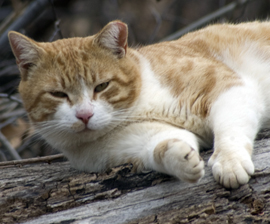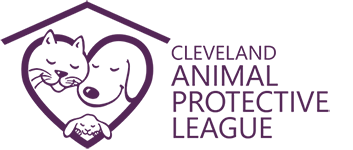 Have you been “adopted” by the cat outside? Feral and free-roaming cats are the largest contributors to the cat overpopulation crisis. Thousands of homeless animals are surrendered to our shelter each year. At the Cleveland APL, we are committed to ending this developing tragedy through our TNR Program. If you are caring for a cat outside, we invite you to be part of the solution to cat overpopulation and take advantage of our services! Through our Animal Welfare Clinic, we are able to offer many helpful services for feral cats and their caretakers.
Have you been “adopted” by the cat outside? Feral and free-roaming cats are the largest contributors to the cat overpopulation crisis. Thousands of homeless animals are surrendered to our shelter each year. At the Cleveland APL, we are committed to ending this developing tragedy through our TNR Program. If you are caring for a cat outside, we invite you to be part of the solution to cat overpopulation and take advantage of our services! Through our Animal Welfare Clinic, we are able to offer many helpful services for feral cats and their caretakers.
What is the Trap-Neuter-Return (TNR) Program?
Trap-Neuter-Return is the only proven method that is both humane and effective at controlling the feral cat population. Each cat that goes through the program is humanely trapped, given vaccinations, spayed or neutered, then returned back to the area where it was trapped. TNR is effective at reducing the “nuisance ” behaviors associated with large groups of cats, some of those being fighting, yowling, spraying, and of course having up to 3 litters a year!
Why Does This Program Work?
Research has proven that old methods of catching and removing cats, either by relocating or euthanasia, only increases the number of cats over time. This phenomenon is called the vacuum effect, click here to learn more. When a cat’s territory is vacated it frees up resources for other cats to take advantage of, regardless of whether cat food is provided or not. When cats are sterilized, vaccinated, and returned, they effectively hold or defend their territory so more cats can’t move in. This in turn stabilizes the area’s population and makes for healthier, better-off cats.
How Does This Program Work?
Our program runs Monday through Friday with a drop off time from 8 to 9 am. We do make appointments, so please call our Clinic Coordinator ahead of time at 216-377-1624 to make arrangements.
*All cats must be transported in a secure carrier or humane trap.
What are the Program Fees?
Cleveland City limits and Cuyahoga County
- Cats and kittens are $10.00
Out of county
- Cats $119 for males, $129 for females
The fee includes:
- Spay or neuter surgery
- Ear-tipping
- Rabies vaccination
- FVRCP vaccination
Additional services available upon request:
- FELV/ FIV Snap test
- Topical flea treatment
- Tapeworm injection
What is Ear Tipping?
Ear tipping is an external identifier that shows when when a cat has been spayed or neutered. It is a procedure that is performed under anesthesia and involves removing approximately ¼ inch off the tip of the cat’s left ear. There are many added benefits for ear tipping outdoor cats. First, it is an easy to spot characteristic that tells the cat is vaccinated, spayed or neutered, and most likely has a care taker. Secondly, the ear tip prevents the cat from undergoing the stress of transportation and sedation at the clinic. This is seen quite frequently at our clinic. Lastly, ear tipping helps caretakers to distinguish who has been altered and who has not.
How Do I Catch and Transport the Cats?
Friendly, stray cats and kittens can be transported in a secure carrier. It is recommended that you introduce the cat(s) to the carrier before the day of your appointment. You may also choose to feed him or her in the carrier so the cat will associate the carrier with something positive.
If the cat is not friendly or approachable, it is recommended to humanely trap him or her. The Cleveland APL has humane traps available for rent for clients. We require a non-refundable fee of $5 per trap and a fully refundable $45 deposit. The fees are collected when the trap is rented. Our TNR Clinic Coordinator, Sarah Dasher will provide a “how-to” demonstration and written instructions with tips on how to successfully and humanely trap feral cats. “How-to” workshops may be coordinated for groups of caretakers and other interested parties free of charge. Please contact our team at 216-255-5022 or via e-mail at CommunityPetClinic@ClevelandAPL.org for more information.


